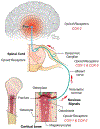Assessment, Quantification, and Management of Fracture Pain: from Animals to the Clinic
- PMID: 32827293
- PMCID: PMC7541703
- DOI: 10.1007/s11914-020-00617-z
Assessment, Quantification, and Management of Fracture Pain: from Animals to the Clinic
Abstract
Purpose of review: Fractures are painful and disabling injuries that can occur due to trauma, especially when compounded with pathologic conditions, such as osteoporosis in older adults. It is well documented that acute pain management plays an integral role in the treatment of orthopedic patients. There is no current therapy available to completely control post-fracture pain that does not interfere with bone healing or have major adverse effects. In this review, we focus on recent advances in the understanding of pain behaviors post-fracture.
Recent findings: We review animal models of bone fracture and the assays that have been developed to assess and quantify spontaneous and evoked pain behaviors, including the two most commonly used assays: dynamic weight bearing and von Frey testing to assess withdrawal from a cutaneous (hindpaw) stimulus. Additionally, we discuss the assessment and quantification of fracture pain in the clinical setting, including the use of numeric pain rating scales, satisfaction with pain relief, and other biopsychosocial factor measurements. We review how pain behaviors in animal models and clinical cases can change with the use of current pain management therapies. We conclude by discussing the use of pain behavioral analyses in assessing potential therapeutic treatment options for addressing acute and chronic fracture pain without compromising fracture healing. There currently is a lack of effective treatment options for fracture pain that reliably relieve pain without potentially interfering with bone healing. Continued development and verification of reliable measurements of fracture pain in both pre-clinical and clinical settings is an essential aspect of continued research into novel analgesic treatments for fracture pain.
Keywords: Animal fracture model; Fracture pain; Nociceptive behaviors; Opioids; Pain management.
Figures

Similar articles
-
New Insights in Understanding and Treating Bone Fracture Pain.Curr Osteoporos Rep. 2018 Aug;16(4):325-332. doi: 10.1007/s11914-018-0446-8. Curr Osteoporos Rep. 2018. PMID: 29948820 Free PMC article. Review.
-
Pain in sickle cell disease: current and potential translational therapies.Transl Res. 2021 Aug;234:141-158. doi: 10.1016/j.trsl.2021.03.007. Epub 2021 Mar 9. Transl Res. 2021. PMID: 33711512 Free PMC article. Review.
-
Analgesic effects of p38 kinase inhibitor treatment on bone fracture healing.Pain. 2009 Mar;142(1-2):116-26. doi: 10.1016/j.pain.2008.12.019. Epub 2009 Jan 23. Pain. 2009. PMID: 19167815
-
Minimal Pain Decrease Between 2 and 4 Weeks After Nonoperative Management of a Displaced Midshaft Clavicle Fracture Is Associated with a High Risk of Symptomatic Nonunion.Clin Orthop Relat Res. 2021 Jan 1;479(1):129-138. doi: 10.1097/CORR.0000000000001411. Clin Orthop Relat Res. 2021. PMID: 32675585 Free PMC article.
-
Mechanisms of acute and chronic pain after surgery: update from findings in experimental animal models.Curr Opin Anaesthesiol. 2018 Oct;31(5):575-585. doi: 10.1097/ACO.0000000000000646. Curr Opin Anaesthesiol. 2018. PMID: 30028733 Review.
Cited by
-
A bad break: mechanisms and assessment of acute and chronic pain after bone fracture.Pain. 2025 May 21:10.1097/j.pain.0000000000003646. doi: 10.1097/j.pain.0000000000003646. Online ahead of print. Pain. 2025. PMID: 40408239
-
Harnessing Healing Power: A Comprehensive Review on Platelet-Rich Plasma in Compound Fracture Care.Cureus. 2024 Jan 22;16(1):e52722. doi: 10.7759/cureus.52722. eCollection 2024 Jan. Cureus. 2024. PMID: 38384641 Free PMC article. Review.
-
Cannabidiol and Cannabigerol, Nonpsychotropic Cannabinoids, as Analgesics that Effectively Manage Bone Fracture Pain and Promote Healing in Mice.J Bone Miner Res. 2023 Nov;38(11):1560-1576. doi: 10.1002/jbmr.4902. Epub 2023 Sep 25. J Bone Miner Res. 2023. PMID: 37597163 Free PMC article.
-
Sustained Morphine Delivery Suppresses Bone Formation and Alters Metabolic and Circulating miRNA Profiles in Male C57BL/6J Mice.J Bone Miner Res. 2022 Nov;37(11):2226-2243. doi: 10.1002/jbmr.4690. Epub 2022 Sep 26. J Bone Miner Res. 2022. PMID: 36054037 Free PMC article.
-
Postoperative rehabilitation training adherence and influencing factors in adults with traumatic fractures in China: a cross-sectional study.BMJ Open. 2025 Jun 6;15(6):e092498. doi: 10.1136/bmjopen-2024-092498. BMJ Open. 2025. PMID: 40480669 Free PMC article.
References
-
- Kanis JA, Oden A, Jolmell O, Jonsson B, de Laet C, Dawson A. The burden of osteoporotic fractures: a method for setting intervention thresholds. Osteoporosis international: a journal established as result of cooperation between the European Foundation for Osteoporosis and the National Osteoporosis Foundation of the USA. 2001; 12(5):417–27. doi:10.1007/s001980170112. - DOI - PubMed
-
- Burge R, Dawson-Hughes B, Solomon DH, Wong JB, King A, Tosteson A. Incidence and economic burden of osteoporosis-related fractures in the United States, 2005–2025. Journal of bone and mineral research : the official journal of the American Society for Bone and Mineral Research. 2007;22(3):465–75. doi:10.1359/jbmr.061113. - DOI - PubMed
Publication types
MeSH terms
Grants and funding
LinkOut - more resources
Full Text Sources
Medical
Research Materials

